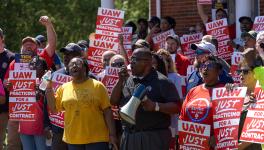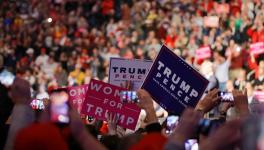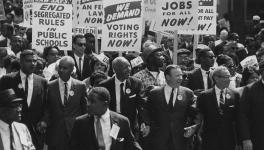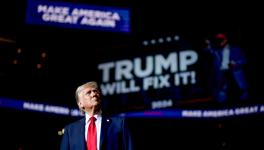An Un-American History of Korea
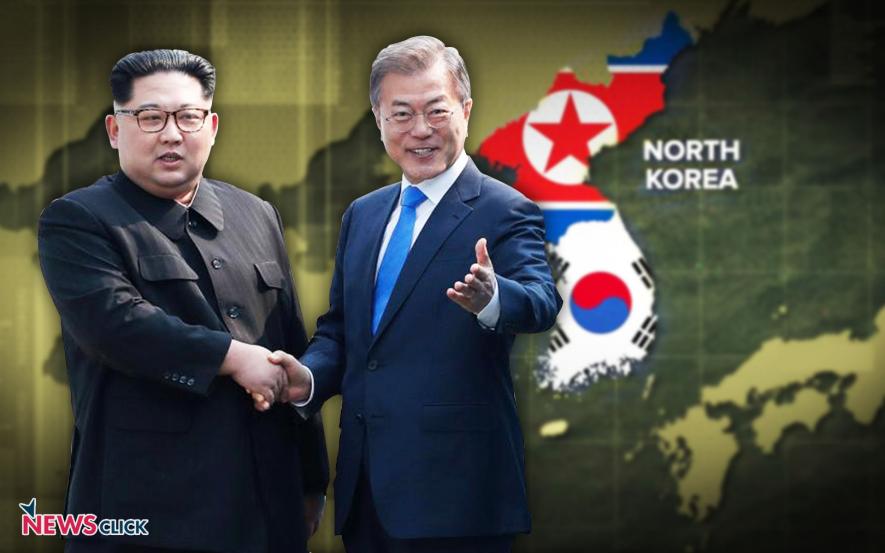
Last week witnessed a major diplomatic breakthrough in the Korean peninsula, with North Korean leader Kim Jong-un and South Korean President Moon Jae-in announcing their decision to pursue a complete denuclearization of the peninsula and to work towards an eventual reunification of the two countries.
If the commitments made by both sides in a joint statement after the summit on April 27 are followed through, it might mark an end to almost seven decades of conflict in the region, which has often led to threats of nuclear escalation.
A peaceful end to the tension requires that the legitimate concerns of the North Korean state be considered and understood, rather than dismissing the regime as ‘evil’, ‘irrational’ or ‘suicidal’’. Lest, the steady movement towards peace may yet again be derailed.
A state built on the corpses of communists
The roots of many of these concerns can be traced to the late 1940s, when Korea was liberated from Japanese occupation after Japan surrender by the end of World War II. Koreans across the peninsula sought to an independent government, and ‘People’s Assemblies’ were held to to this end. However, at the urging of the United States, the Soviet Union agreed that the peninsula be divided at the 38th parallel “until such time as an independent government, desirable to the victorious powers could be established,” Harry R. Targ wrote.
Syngman Rhee, who was to become the first president of South Korea, was flown in from Washington on a U.S passport in General Douglas MacArthur’s personal airplane to form a government in the U.S-occupied South. With ties to large landowners, Rhee was “not popular with South Korean farmers, many of whom rebelled against the new government.”
Most personnel running this government were former collaborators with the Japanese colonial government. By the CIA’s own admission, the government bureaucracy, “was substantially the old Japanese machinery.” Former collaborators with Japanese imperialism continued to rule South Korea for decades. For example, Park Chung Hee, who had served as an officer in the Japanese Imperial Army, seized power in South Korea in 1961 through a military coup.
The prospect of the former colonial machinery’s continuation provoked fierce resistance in South Korea. The left-wing People’s Committees responded with uprisings across the southern provinces. With help from U.S advisers, these uprisings were crushed brutally by Rhee’s government.
The suppression of dissent in Cheju island was revealing of the brutality of this regime. Historian Bruce Cumings, in his authoritative account of the Korean war, wrote: “Following Japanese counterinsurgency practices, the entire island interior was declared an enemy zone, villagers were forcibly relocated to the coast, and the mountains.. were blockaded. More than half of all villages on the mountain slopes were burned and destroyed, and civilians thought to be aiding the insurgents were massacred. Civilians were by far the largest category of victims, some killed by the insurgents, but the vast majority by police and right-wing youth squads. Women, children and the elderly who were left behind were tortured to gain information on insurgents, and then killed."
With the help of U.S advisor James Hausman, the uprising in the port city of Yosu was also crushed. Acknowledging that the regime’s national police were “brutal bastards” who were “worse than the Japanese”, Hausman “sought to make their brutality more efficient by showing them, for example, how to douse corpses of executed people with gasoline, thus to hide the method of execution or blame it on communists.” It was on the dead bodies of a 100,000 communists and dissidents that the Rhee government's control over the southern provinces was established.
The regime established in the North with the support of the Soviet Union was not free of authoritarian tendencies, but Kim Il-sung, who headed the government, was popular for having fought in many guerrilla wars against the Japanese imperial forces.
When 30% of North Korea’s population died in bombings
With both Kim and Rhee committed to unify the Korea under their respective regimes, the Korean war broke out on June 25, 1950. Within a few days, South Korean armed forces were placed under the command of General MacArthur. A total of 17 countries provided combat troops to back South Korea under the United Nations Command (UNC) set up the the U.N Security Council. By the time the war came to a close, of the 932,964 UNC troops, only 590,911 were South Korean.
After China sent armed ‘volunteers’ to back North Korea, General MacArthur called for the use of nuclear weapons. Cummings wrote, “On 9 December, MacArthur said that he wanted commander's discretion to use atomic weapons in the Korean theatre. On 24 December, he submitted "a list of retardation targets" for which he required 26 atomic bombs. He also wanted four to drop on the "invasion forces" and four more for "critical concentrations of enemy air power”.”
Later, in an interview in 1954, General MacArthur, unhappy at not having had his way, would talk about his plan to drop 30-50 tactical atomic bombs on enemy air bases and depots. While MacArthur was removed from his position by President Truman, the U.S air force's bombing campaign across North Korea, which included the widespread use of napalm, obliterated 18 of North Korea’s 22 cities. The big industrial cities of Hamhung and Hungnam were 80-85% destroyed, Sariwon, 95%; Sinanju, 100%; the port of Chinnampo, 80% ;and Pyongyang 75%.
The extent of destruction of urban areas exceeded, by the U.S Air Force’s own estimation, that in Japan after the nuclear attacks on Hiroshima and Nagasaki. War correspondent Tibor Meray, who had witnessed the war, said there were virtually “no more cities in North Korea.” Up to 30% of North Korea’s population was wiped out. General Curtis LeMay, who headed the Strategic Air Command, bragged, “Over a period of three years or so, we killed off - what - 20% of the population.”
U.S deploys nuclear weapons in South Korea
In June 1953, an armistice was signed between the US, China and North Korea. Syngman Rhee, who wanted to fight on till the entire North was under his control, refused to sign the armistice, but grudgingly agreed to abide by it.
Article 13(d) of the armistice prohibited both the warring sides from introducing any new combat machines or ammunitions, except for replacing those that had been used up or worn out during the armistice period on a piece-to-piece basis. However, barely five years later, the U.S began to deploy nuclear weapons in the South. In January 1958, at least four nuclear weapon systems - including the Honest John surface-to-surface missile, the Atomic Demolition Munition nuclear landmine, and two nuclear artillery weapons - were deployed by U.S in South Korea, which by then had approximately 150 warheads.
This was quickly followed with the deployment of Matador cruise missiles, before nuclear bombs were loaded on fighter-bombers in March that year. Between July 1960 and September 1963, three surface-to-surface missile systems were deployed, apart from the dual-mission Hercules anti-air and surface-to-surface missiles, which were introduced in January 1961. “At the peak of this build-up, in 1967, eight weapon systems with a total of 950 nuclear warheads were deployed in South Korea,” according to a paper in the Bulletin of the Atomic Scientists.
A tale of betrayal
It was only in the 1980s that North Korea started developing its nuclear arsenal. The country refused to comply with the terms of The Treaty on the Non-Proliferation of Nuclear Weapons (NPT) it had acceded to in 1985, unless the U.S withdrew the nuclear weapons it had placed in the South. Until such withdrawal took place, North Korea maintained that it will not allow the International Atomic Energy Agency (IAEA) to inspect its nuclear capabilities.
By early 1990's, North Korea was in a position to create fissile material from its 5 megawatt reactor in Yongbyon. Plans were also initiated to built two Light Water Reactors of 50 megawatt and 200 megawatt capacity for electricity production. Once all the planned infrastructure was set up, North Korea would have been capable of producing 20-25 bombs per year.
However, by the end of 1991, President George H.W. Bush withdrew the nuclear weapons U.S had placed in South Korea, though North Korean cities were still within the range of the nuclear weapons on U.S submarines. Following this, President Roh Tae Woo of South Korea, through the Declaration on the Denuclearization of the Korean Peninsula, promised not to produce or possess nuclear weapons, or nuclear reprocessing and uranium enrichment facilities, in order to satisfy the terms set by North Korea to allow IAEA inspections of its nuclear facilities.
Subsequently, North and South Korea signed the 'Joint Declaration on the Denuclearization of the Korean Peninsula', in which both the countries agreed to "not test, manufacture, produce, receive, possess, store, deploy or use nuclear weapons," and to allow the required inspections to verify denuclearization.
After a few setbacks, the IAEA in May 1994, confirmed that North Korea had begun removing spent fuel from its 5 megawatt nuclear reactor. A few months later, in October that year, the US and North Korea signed an agreement for denuclearization of the Korean peninsula, in accordance with which, North Korea was required to dismantle its graphite-moderated reactors and related facilities, and allow the spent fuel to be removed from its 5 megawatt reactor and disposed safely in order to not allow the State to reprocess the fuel.
In return, the U.S would be required to "organize under its leadership an international consortium to finance and supply" the Light Water Reactor (LWR) in North Korea. During the period when the setting up of this LWR was underway, "to offset the energy foregone due to the freeze of graphite - moderated reactors and related facilities", the U.S was to provide North Korea with “alternative energy in form of heavy oil for heating and electricity production”. The deliveries of heavy oil were to begin within three months of the signing of the agreement and were to "reach a rate of 500,000 tons annually.”
North Korea “did carry out its part of the bargain. It dismantled its reactors and put its spent fuel rods under IAEA safeguards.” However, “the US never held up its side of the bargain. By 2002, instead of the two [LWRs] being finished as agreed, only some civil works had started. The fuel oil shipments, supposed to continue as long as the reactors were being built, were only sporadic.”
Things took a turn for the worse when, George W. Bush’s administration identified North Korea as part of the “Axis of evil” after the September 11 attacks on the World Trade Centre. Citing North Korea’s import of centrifuges from Pakistan for an enrichment program - which was not prohibited under any clause of the Agreed Framework - as a violation of the 'spirit' of the agreement, the U.S walked out of the deal, without addressing the fact that it had violated the agreement in ‘letter’.
That the import of centrifuges was a mere excuse was clear from U.S diplomat John Bolton’s statement: “This was the hammer I had been looking for to shatter the Agreed Framework.”
After U.S thus broke the agreement, North Korea walked out of the NPT and recovered from IAEA the spent fuel rods it had handed over. Throughout the last decade, as a series of negotiations proved unsuccessful, North Korea developed its nuclear and missile technology. Its missiles now can not only reach Japan and US military bases in Okinawa and Guam, but also any part of the continental United States, according to David Wright, a member of the Union of Concerned Scientists.
Meanwhile, the US and South Korea have been jointly conducting annual 'defensive' joint military exercises year after year, which simulate landings on North Korean beaches, air strikes etc. Each year, during these war games, North Korea is forced to put its security forces on high alert, mobilizing its reserves at an enormous cost to the economy, in order to be prepared for the contingency of the simulation turning into a real invasion.
Currently, about 28,500 U.S troops are stationed in South Korea. In case of a war, the armed forces of South Korea will also be put under the command of the US. Approximately 50,000 more US troops are stationed in 23 military bases across Japan. U.S nuclear-armed submarines capable of striking North Korea also patrol the waters.
Surrounded by such lethal fire-power, a credible nuclear arsenal appears to be the only deterrent North Korea can count on. It is worth noting that having developed such an arsenal at a great cost, North Korea has yet again come to the table to negotiate the terms for denuclearization.
A glimmer of hope
Until recently, North Korea had set as preconditions for denuclearization: the removal of U.S troops in South Korea, the ending of the U.S nuclear umbrella and termination of annual joint military exercises by U.S and South Korean troops. However, as it became clear that such preconditions will not carry the negotiations forward, North Korea has been willing to make further concessions.
In fact, South Korean President Moon Jae-in, who has taken considerable measures to win the confidence of the North Korean leadership, recently stated that North Korea has “not attached any conditions that the U.S. cannot accept, such as the withdrawal of American troops from South Korea. All they are expressing is the end of hostile policies against North Korea, followed by a guarantee of security.”
In the joint statement of April 27, the countries reiterated their commitment to achieve a complete denuclearization of the Korean peninsula, apart from ceasing military hostilities, pursuing an official peace accord and working towards reunification. However, no peace accord can be completed without credible security assurances to North Korea from the U.S, which risks losing its rationale for maintaining a huge military presence in the region, if peace reigns on the peninsula.
While President Trump might be happy to claim credit for a peace-deal, whether the American establishment will try to sabotage the attempts made by the two Koreas to succeed is a question yet to be answered.
Get the latest reports & analysis with people's perspective on Protests, movements & deep analytical videos, discussions of the current affairs in your Telegram app. Subscribe to NewsClick's Telegram channel & get Real-Time updates on stories, as they get published on our website.











